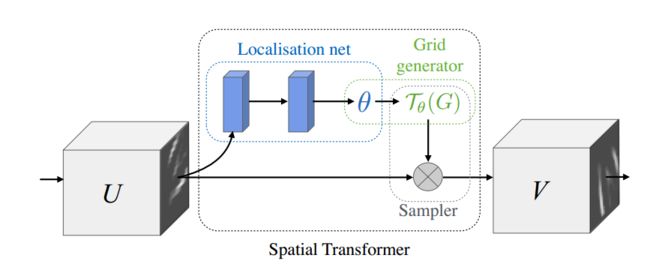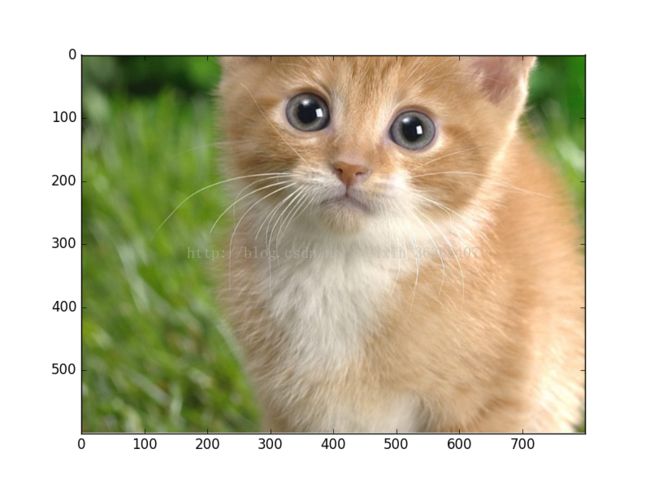Tensorflow1.0空间变换网络(SpatialTransformer Networks)实现
空间变换网络简单介绍:
- 通过locatnet,提取输入图像的theta(将用于仿射变换);
- 根据输入图像的width和height以及仿射变换(或者TPS)的参数theta,可以生成目标位置在输入图像(U)中对应的位置(与输入图像位置一直的目标索引);
(由torch.bmm, Batch matrix matrix product of matrices生成)。 - 根据目标在输入图像中的对应位置(索引矩阵)利用双线性插值得到目标输出。
先给大家展示一下效果:
代码部分:
import tensorflow as tf
def transformer(U, theta, out_size, name='SpatialTransformer', **kwargs):
print('beigin-transformer')
def _repeat(x, n_repeats):
with tf.variable_scope('_repeat'):
rep = tf.transpose(
tf.expand_dims(tf.ones(shape=tf.stack([n_repeats, ])), 1), [1, 0])
rep = tf.cast(rep, 'int32')
x = tf.matmul(tf.reshape(x, (-1, 1)), rep)
return tf.reshape(x, [-1])
def _interpolate(im, x, y, out_size):
with tf.variable_scope('_interpolate'):
# constants
num_batch = tf.shape(im)[0]
height = tf.shape(im)[1]
width = tf.shape(im)[2]
channels = tf.shape(im)[3]
x = tf.cast(x, 'float32')
y = tf.cast(y, 'float32')
height_f = tf.cast(height, 'float32')
width_f = tf.cast(width, 'float32')
out_height = out_size[0]
out_width = out_size[1]
zero = tf.zeros([], dtype='int32')
max_y = tf.cast(tf.shape(im)[1] - 1, 'int32')
max_x = tf.cast(tf.shape(im)[2] - 1, 'int32')
# scale indices from [-1, 1] to [0, width/height]
x = (x + 1.0)*(width_f) / 2.0
y = (y + 1.0)*(height_f) / 2.0
# do sampling
x0 = tf.cast(tf.floor(x), 'int32')
x1 = x0 + 1
y0 = tf.cast(tf.floor(y), 'int32')
y1 = y0 + 1
x0 = tf.clip_by_value(x0, zero, max_x)
x1 = tf.clip_by_value(x1, zero, max_x)
y0 = tf.clip_by_value(y0, zero, max_y)
y1 = tf.clip_by_value(y1, zero, max_y)
dim2 = width
dim1 = width*height
base = _repeat(tf.range(num_batch)*dim1, out_height*out_width)
base_y0 = base + y0*dim2
base_y1 = base + y1*dim2
idx_a = base_y0 + x0
idx_b = base_y1 + x0
idx_c = base_y0 + x1
idx_d = base_y1 + x1
# use indices to lookup pixels in the flat image and restore
# channels dim
im_flat = tf.reshape(im, tf.stack([-1, channels]))
im_flat = tf.cast(im_flat, 'float32')
Ia = tf.gather(im_flat, idx_a)
Ib = tf.gather(im_flat, idx_b)
Ic = tf.gather(im_flat, idx_c)
Id = tf.gather(im_flat, idx_d)
# and finally calculate interpolated values
x0_f = tf.cast(x0, 'float32')
x1_f = tf.cast(x1, 'float32')
y0_f = tf.cast(y0, 'float32')
y1_f = tf.cast(y1, 'float32')
wa = tf.expand_dims(((x1_f-x) * (y1_f-y)), 1)
wb = tf.expand_dims(((x1_f-x) * (y-y0_f)), 1)
wc = tf.expand_dims(((x-x0_f) * (y1_f-y)), 1)
wd = tf.expand_dims(((x-x0_f) * (y-y0_f)), 1)
output = tf.add_n([wa*Ia, wb*Ib, wc*Ic, wd*Id])
return output
def _meshgrid(height, width):
print('begin--meshgrid')
with tf.variable_scope('_meshgrid'):
# This should be equivalent to:
# x_t, y_t = np.meshgrid(np.linspace(-1, 1, width),
# np.linspace(-1, 1, height))
# ones = np.ones(np.prod(x_t.shape))
# grid = np.vstack([x_t.flatten(), y_t.flatten(), ones])
x_t = tf.matmul(tf.ones(shape=tf.stack([height, 1])),
tf.transpose(tf.expand_dims(tf.linspace(-1.0, 1.0, width), 1), [1, 0]))
print('meshgrid_x_t_ok')
y_t = tf.matmul(tf.expand_dims(tf.linspace(-1.0, 1.0, height), 1),
tf.ones(shape=tf.stack([1, width])))
print('meshgrid_y_t_ok')
x_t_flat = tf.reshape(x_t, (1, -1))
y_t_flat = tf.reshape(y_t, (1, -1))
print('meshgrid_flat_t_ok')
ones = tf.ones_like(x_t_flat)
print('meshgrid_ones_ok')
print(x_t_flat)
print(y_t_flat)
print(ones)
grid = tf.concat( [x_t_flat, y_t_flat, ones],0)
print ('over_meshgrid')
return grid
def _transform(theta, input_dim, out_size):
print('_transform')
with tf.variable_scope('_transform'):
num_batch = tf.shape(input_dim)[0]
height = tf.shape(input_dim)[1]
width = tf.shape(input_dim)[2]
num_channels = tf.shape(input_dim)[3]
theta = tf.reshape(theta, (-1, 2, 3))
theta = tf.cast(theta, 'float32')
# grid of (x_t, y_t, 1), eq (1) in ref [1]
height_f = tf.cast(height, 'float32')
width_f = tf.cast(width, 'float32')
out_height = out_size[0]
out_width = out_size[1]
grid = _meshgrid(out_height, out_width)
grid = tf.expand_dims(grid, 0)
grid = tf.reshape(grid, [-1])
grid = tf.tile(grid, tf.stack([num_batch]))
grid = tf.reshape(grid, tf.stack([num_batch, 3, -1]))
#tf.batch_matrix_diag
# Transform A x (x_t, y_t, 1)^T -> (x_s, y_s)
print('begin--batch--matmul')
T_g = tf.matmul(theta, grid)
x_s = tf.slice(T_g, [0, 0, 0], [-1, 1, -1])
y_s = tf.slice(T_g, [0, 1, 0], [-1, 1, -1])
x_s_flat = tf.reshape(x_s, [-1])
y_s_flat = tf.reshape(y_s, [-1])
input_transformed = _interpolate(
input_dim, x_s_flat, y_s_flat,
out_size)
output = tf.reshape(
input_transformed, tf.stack([num_batch, out_height, out_width, num_channels]))
print('over_transformer')
return output
with tf.variable_scope(name):
output = _transform(theta, U, out_size)
return output
def batch_transformer(U, thetas, out_size, name='BatchSpatialTransformer'):
with tf.variable_scope(name):
num_batch, num_transforms = map(int, thetas.get_shape().as_list()[:2])
indices = [[i]*num_transforms for i in xrange(num_batch)]
input_repeated = tf.gather(U, tf.reshape(indices, [-1]))
return transformer(input_repeated, thetas, out_size)from scipy import ndimage
import tensorflow as tf
from STN_tf_01 import transformer
import numpy as np
import matplotlib.pyplot as plt
import cv2
im=ndimage.imread('C:\\Users\\hasee\\Desktop\\cat.jpg')
im=im/255.
#im=tf.reshape(im, [1,1200,1600,3])
im=im.reshape(1,1200,1600,3)
im=im.astype('float32')
print('img-over')
out_size=(600,800)
batch=np.append(im,im,axis=0)
batch=np.append(batch,im,axis=0)
num_batch=3
x=tf.placeholder(tf.float32,[None,1200,1600,3])
x=tf.cast(batch,'float32')
print('begin---')
with tf.variable_scope('spatial_transformer_0'):
n_fc=6
w_fc1=tf.Variable(tf.Variable(tf.zeros([1200*1600*3,n_fc]),name='W_fc1'))
initial=np.array([[0.5,0,0],[0,0.5,0]])
initial=initial.astype('float32')
initial=initial.flatten()
b_fc1=tf.Variable(initial_value=initial,name='b_fc1')
h_fc1=tf.matmul(tf.zeros([num_batch,1200*1600*3]),w_fc1)+b_fc1
print(x,h_fc1,out_size)
h_trans=transformer(x,h_fc1,out_size)
sess=tf.Session()
sess.run(tf.global_variables_initializer())
y=sess.run(h_trans,feed_dict={x:batch})
plt.imshow(y[0])
plt.show()

